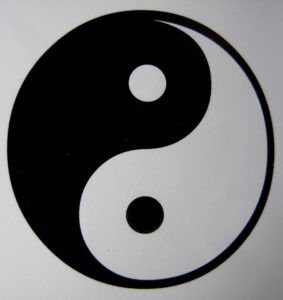
On Sunday, The Atlantic Coast Pipeline, a project that threatened the sanctity of life on Roberts Mountain, was cancelled by its sponsoring companies. The impact of the coronavirus creating a world energy glut laid bare the truth that the cost of fracking and transporting natural gas via the pipeline was a financial absurdity. Even the recent Supreme Court decision to remove all regulatory roadblocks to the pipeline could not justify this 8 billion dollar project to its investors.
In our joy, Jan and I clearly realized that the world is now in the time of the Turning Point, hexagram number 24 in the I Ching. The corporate decision was announced between thunderstorms. The Turning Point is composed of thunder beneath the Earth. Five Yin lines rest upon a Yang line at the bottom of the hexagram. The energy of new life is stirring in the Earth, and the heart. The Turning Point is the first substantial sign of long-awaited change; may it be handled with care. Here are the I Ching’s cautionary guidelines, interpreted from and with my personal insights:
Nine in the first place: To stray from the truth of the heart in small digressions is natural, however, be sure to turn around before a habit is formed. If one is enlightened of one’s illusion, shift position and embrace the truth. No shame is attached to abandoning that which does not serve the high Soul or the common good.
Six in the second place: Here the ego is encouraged to quietly subordinate itself to the truth of the heart, the intent of the high Soul. “Quiet”, writes Aurobindo (Powers Within, p. 120), “is a condition in which there is no restlessness or disturbance.” Ego is deeply calm when it acts upon its true vocation, the intent of its high Soul. Meditative practice that masters the automatic reactions of the autonomic nervous system can support this relationship.
Six in the third place: Here we encounter the Sisyphus of constantly doing that which I would not. These are the reversals of good resolutions brought on by the desire body’s influence upon a receptive ego. Ultimately, this is not a disaster; one simply will have to do it over again until one gets it right.
Six in the fourth place: Stay connected to your inner truth. We are surrounded by contrary views and the opinions of others. The power of true connection with one’s high Soul is the only friend one will ever need. There is no need to prove anything to anyone, proof rests in the knowing heart.
Six in the fifth place: Assume responsibility for manifesting your high Soul’s intent for your life. This requires deep self examination and honesty on the part of the ego. Admitting and relinquishing one’s attachment to illusions frees tremendous energy for one’s true mission, the intent of the high Soul.
Six at the top: Beware of blind obstinacy, it leads to misfortune. Refusal to answer the call of the high Soul ensnares one in an ever-deepening rift from right action; a slippery slope into the abyss. Mortality has its limits.
In summary, the time of the Turning Point is most auspicious. The underlying burst of energy to initiate change has arrived. However, as the guidance emphasizes, much effort in shaping needed change rests in the hands of the ego, which must first and foremost wrestle with its humanness.
Humanness is often governed by the inherent archetypes, the ruling parents. We are all children of those archetypes, charged with transcending their governance through arriving at right action, rooted in the truth of the heart center.
Nature is providing us with the thunder, let’s use it wisely.
At the Turning Point,
Chuck



